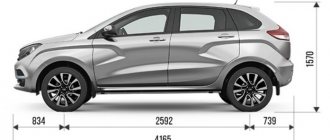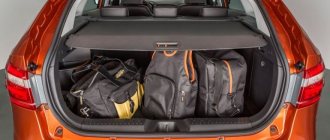In the fall of 2022, the VAZ automobile concern presented to the public new models designed for family use and long trips. The updated generation received two modifications at once: Lada Vesta SW Cross and Lada Vesta SW. The first car is designed for the urban cycle, relatively smooth roads, moderate loads, while the standard suspension cannot withstand movement on bumpy terrain. The second option was created in a reinforced version and is used primarily for off-road, dirt roads, and long hikes by outdoor enthusiasts.
Is it possible to put a roof rack on Vesta (sedan)
The only way to increase the carrying capacity of Vesta without purchasing a trailer is to install a luggage box on the roof. The manufacturer did not formally agree on this, but on the Lada website they offer to buy a set of transverse bars for installation.
Autobox on the roof of Vesta. Photo source: https://www.drive2.ru/l/494336305753227994/
Unlike modifications with a station wagon body, the sedan does not have an integrated roof rail to which such crossbars can be attached - they are installed with fastenings in the door openings.
The Lada Vesta trunk is made by domestic manufacturers:
- Trademark LUX from Moscow.
- Petersburg, producing products under the Atlant brand.
- Products "Eurodetal" from Rostov-on-Don.
Craftsmen install imported universal-class car racks on the roof of Vesta sedans: Wingbar from Thule (Sweden), Turtle Air-2 from Can Otomotiv (Turkey), Menabo Lince (Italy). The price of a domestic set of cross rails for a smooth sedan roof is in the range of 4-6 thousand rubles, imported - from 9 to 20 thousand.
Manufacturers and prices of car boxes
The autobox is purchased by the driver separately from the cargo system (cross rails), since it is universal in mounting. There are dozens of types and sizes of boxes, differing in volume, design, and reliability of protection of the transported cargo.
Possible volumes of boxes are from 300 liters to 1000 liters, although for Lada there is no point in installing more than 480 liters, because the aerodynamics will not allow you to drive fast, the additional gasoline consumption will exceed 5 liters per hundred. The maximum weight of cargo on the roof is 75 kg.
The choice on the market is huge, and you can even find the flagship models of the Swedish Thule on domestic Ladas. There are not many brands that are actually available. Popular domestic ones:
- Europart volume from 300 to 420 liters, prices from 10 to 16 thousand rubles;
- LUX (Lux) 175 and 370 l, about 15-16 thousand rubles;
- TERRA DRIVE up to 480 l, about 20 thousand rubles;
- Yuago from Tolyatti, from 390 to 580 l, 10-20 thousand rubles.
For comparison: Swedish Thule costs from 30 thousand rubles. (300 l) up to 65 thousand rubles. (500 l).
Comparison of trunk parameters with other Lada models
Technical characteristics of the car Lada (VAZ) 21703 (priora) (2007(2013)). Lada 217030 technical specifications. 217030 Lada Priora
Thanks for subscribing!
To compare the capacity parameters, consider other AvtoVAZ models:
- Vesta's predecessor, Lada Granta (sedan) has 520-liter luggage space. Folding the seat backs increases the volume to 840 liters. Parameters of Grants in a hatchback body – 440 liters and plus 320 liters when access to the interior is opened. Grants in the station wagon body have the smallest volume, which is 355 (670) liters.
- The internal luggage space of the Lada Priora sedan is 430 liters, the station wagon – 444 liters, the hatchback – 360 liters.
- Lada Kalina has parameters: 240/550 (hatchback), 355/670 (station wagon)
- The Lada Largus station wagon can accommodate up to 2350 liters of luggage, and the van body is even larger - 2540.
As you can see, the last point especially stands out in this list due to the fact that Largus was created for the transportation of bulk cargo. The other models are approximately at the same level, and Vesta is only ahead of Grant by 40 liters.
The main thing is volume
The capacity of cargo compartments of Lada Vesta cars ranges from 430 to 500 liters. The list includes the following models:
- sedan;
- hatchback;
- cross;
- station wagon
You also need to consider Kalina and Priora. For comparison, the review presents competitive models from foreign manufacturers.
The characteristics of the Lada Vesta sedan have not been a secret for a long time. After the release of the first production models, all overall dimensions of the car were officially revealed. The trunk of the sedan model holds 480 liters. Convenient loading is ensured by a low threshold, an internal handle, a significant amplitude of opening the lid and not very large wheel arches.
For comparison, the Kia Solaris trunk has a capacity of only 470 liters, and the leaders in this line are the Datsun on-Do and Skoda Rapid with a cargo compartment volume of 530 liters.
Dimensions and parameters of Lada Vesta
Review of Lada Niva Travel 2021-2022 - technical specifications and photos
In anticipation of the appearance of the new domestic Lada Vesta sedan for free sale on the Russian market, fragmentary data about its characteristics literally drove car enthusiasts thirsty for details crazy. A special part of the intrigue was the dimensions of the Lada Vesta, announced as the successor to the Lada Priora.
Longer, wider, higher - a serious bid for leadership
The new Lada sedan announced its serious potential as a highly competitive player in its market segment almost immediately. A new bright design, an attractive price, a stylish and comfortable interior, decent technical equipment and the largest overall dimensions in the B-class, significantly superior in all respects to models on the market in the corresponding segment.
If we follow the classification of the European standard, the car would be more correctly classified as the existing intermediate class B+, very close to business class C.
The length of the new sedan is 4.41 meters, which is 4 centimeters longer than the best-sellers in the Russian automobile market - Hyundai Solaris and Kia Rio. Vesta has grown by as much as 15 centimeters compared to the previous generation of AvtoVAZ sedans - Lada Granta.
The width of the car also inspires respect - 1764 millimeters, which is 6.5 cm ahead of its closest rivals, being a leading indicator in the class. The height measured in fully loaded condition for the new domestically produced sedan will be 1,497 meters, which is as close as possible to those of a higher class of car.
Completely superior to competitors in overall dimensions - the length and width of the sedan are class leading - the car has a much more impressive and solid appearance. The massive body of the new Vesta really has great similarities both in appearance and in the level of comfort of movement with representatives of the C-class, which was initially more luxurious and expensive.
Comfort of movement in Russian realities
The new Lada Vesta sedan was initially designed for comfortable operation on not always ideal Russian roads. By increasing the wheelbase - its size is 2635 mm according to technical specifications - Vesta's directional stability and handling on roads with uneven surfaces are improved.
This figure is 6.5 centimeters higher than its Korean classmates and 8.3 centimeters higher than the same distance in the Volkswagen Polo sedan, the market leader in the B segment. The solid distance between the front and rear wheel axles gives confidence even in the presence of rutting and prevents rearrangements when moving. The massive sedan allows the driver and passengers to enjoy the comfort of a smooth ride, avoiding sudden shaking and jumps.
Like all Russian-made cars, Lada Vesta boasts increased ground clearance. It is 171 mm from the crankcase of the engine unit for a fully loaded car, which will be a significant advantage for driving a car in light off-road conditions, for example, on country roads.
The curb weight of the sedan depends on the modification of the car and ranges from 1150 kg in the basic version and up to 1195 kg in the top version. When taking into account the power of the corresponding power units, the weight ratio index ranges from 6.6 to 8, which characterizes decent dynamics of the Lada Vesta.
Spacious interior and impressive trunk
Thanks to the new platform, Lada Vesta boasts decent dimensions, providing its owner with a lot of additional advantages. An undoubted advantage for both the driver and passengers will be the spaciousness in the cabin, allowing you to sit comfortably and comfortably.
The highest length and width indicators in the class not only bring the sedan closer to executive-level cars in terms of handling and interior ergonomics, but also provide the owner with a large Lada Vesta trunk of the correct shape with a useful volume of 480 liters, which is very useful - after all, in addition to the average driver, according to In terms of payload, the sedan can carry a load weighing about 400 kg.
In comparison of the Lada Vesta with the expected new product on the market - the Lada X-Ray crossover, it can be noted that the sedan is 6.5 cm longer and has the same body width. Vesta's wheelbase is wider - 2,592 m versus 2,635 m for X-Ray. Naturally, the ground clearance and height of the crossover are significantly higher than those of a sedan, in accordance with the characteristics of the class.
vestateam.ru
Fuel consumption: which Vesta is the most voracious
Less fuel is consumed during measured, deliberate driving. The absence of sudden braking and acceleration depends on the driver himself, however, the most experienced driver will not do without jerks in city mode. A lower-power engine and an automated transmission use gasoline more economically.
Let's start with the most economical option: a sedan with a 21129 engine (fuel tank volume is 55 liters) and a five-speed AMT. In mixed mode, consumption is 6.6 liters per 100 kilometers, in city mode - 9, in suburban mode - 5.3. A car with the same engine with a manual transmission consumes 9.3 liters in the city, 5.5 liters on the highway, 6.9 mixed. For a Lada with 21179 internal combustion engines on the robot, the numbers are as follows: city - 9.3, highway - 6, mixed - 7.2.
The Lada station wagon in the simplest configuration (106 hp, MT) consumes 9.5 liters of fuel in the urban cycle, 5.9 liters in the extra-urban cycle, and 7.3 liters in the mixed cycle. With the robot, these figures are reduced by 0.3 liters. With a more powerful engine and manual transmission, consumption in the city increases to 10.6 liters, on the highway to 6.3 liters, the average consumption rate is 7.8; with a robot, in the city you need to fill 9.9 liters of fuel for 100 kilometers; for a country trip, 6.2 liters will be enough, the average figure is 7.6. It is worth considering that 95 liters of gasoline will last a longer distance than 92 liters.
Vesta Cross is the most “voracious”. Fuel consumption in the urban cycle is 9.7 liters per 100 km for manual 1.6; 10.7 for mechanics 1.8 and 10.1 for robot 1.8. In free high-speed driving mode, the car spends 6.0; 6.4; 6.3. The combined cycle on the Lada Vesta Cross ranges from 7.5 to 7.9 liters.
Trunk of Lada Vesta (sedan)
Color options for Lada Vesta (+photo)
The trunk volume of the Lada Vesta, according to the AvtoVAZ plant, is 480 liters, which is quite a lot. Allows you to load almost any household item, including large household appliances, garden tools or construction equipment.
Lada Vesta with an open trunk. Photo source: https://www.drive2.ru/o/b/477728182615670898
For comparison, the trunks of other models of the same plant are as follows:
- Priora: sedan - 430 l, station wagon - 444 l, hatchback - 360 l.
- Kalina: hatchback – 240 l, station wagon – 355 l.
- Granta: sedan – 520 l, hatchback – 440 l.
- Largus: station wagon - 2350 l, van - 2540 l.
Thus, the trunk volume of the Lada Vesta in liters, although much inferior to the Largus (which was initially positioned as a cargo-passenger version). However, it is only slightly smaller than the Granta sedan and significantly ahead of Kalina and Priora.
The ability to transport oversized cargo increases even more if you fold down the rear seat backrest. The Vesta station wagon's interior allows you to do this completely - when the backrests are lowered, the rear seats fold in the same plane as the trunk floor (in the sedan there is a 10-centimeter step). In the resulting free volume you can place long things: skis and fishing rods, gardening tools (rakes with shovels, seedlings) and even bicycles.
Even the refrigerator fit. Photo source: https://www.drive2.ru/l/506201410606466102/
If even this size is not enough, it is additionally possible to recline the back of the front passenger seat. Then, in the cabin of a regular Vesta sedan it is possible to transport things longer than 2 m, such as slats and baseboards for repairs, rolled up carpets and similar utensils.
In order to represent the dimensions of the luggage space of the Vesta sedan even more accurately and not end up in an unpleasant situation when an item purchased in a store does not fit in the car, independent auto experts took measurements. Here is their result:
- The length of the luggage compartment is 96.2 cm, with the rear seatbacks folded down – 167.5 cm.
- Width: maximum – 142.4 cm, minimum – 103.9 cm.
- Height with lid closed – 57.3 cm.
The loading height to which the cargo will have to be raised when placing it in the car is 71 centimeters.
If there is an urgent need to transport an even larger load, it is possible to dismantle the false floor of the spare tire compartment. If you remove the spare wheel itself, an additional volume of 95 liters will be freed up, which will increase Vesta’s trunk to a total of 575 liters.
Will 4 wheels fit into the trunk of Vesta?
Among those interested in cars, they argue about the merits of different models, using arguments that are not always clear to the uninitiated. One of the prejudices was the opinion that the trunk of a car is good or bad depending on whether it is possible to fit a spare set of tires in it.
The trunk of the Lada Vesta sedan successfully passes this unofficial test. All 4 standard wheels are loaded into it.
Photo from the forum of Lada Vesta owners as confirmation - four wheels of size 185/65 R15 in the trunk of the sedan. There is free space left for the tool:
4 wheels in the trunk. Photo source: https://www.drive2.ru/l/512298202582483869/
Winter tires on standard alloy wheels 195/55 R16. The trunk lid closes without problems.
Is Lada Vesta convenient for the driver and passengers?
According to owners' reviews, the car's capacity is comparable to representatives of the golf class - Ford Focus and Kia Sid. The front seats are comfortable, their shape (the best in its class) and upholstery are pleasing. But some drivers find the seats not soft enough and complain that the side supports are unreliable and wrinkle. However, the non-slip material of the covers keeps the crew in place during sharp turns of the car.
Tall passengers in the rear are uncomfortable due to the sloping roof: people taller than 175 cm touch the ceiling with their heads while driving. But the rear row of seats is heated, and a separate lamp is provided for passengers. A folding armrest and cup holders add convenience.
"Lada Vesta" lime. Photo source: https://www.drive2.ru/l/476513222266978343/?m=476567648092553217
Owners find few mistakes in interior ergonomics, especially since the manufacturer corrects them. Thus, the holes for the front cup holders were deepened, the door latches were strengthened, and the configuration of the front elbow rest was improved.
Car owners unanimously note excellent sound insulation. The trip is not tiring; travelers can speak in a low voice. A good fit of plastic parts does not produce “crickets” - squeaks.
The large steering wheel with thin spokes is called comfortable, the braid is pleasant to the touch. Many people lack a platform for their left foot: in case of sharp maneuvers, they cannot rest on the floor.
Article source: https://avtoshark.com/lada/vesta/body/lada-vesta-gabarity/
Lada Vesta Cross - detailed review of the trunk and interior
Not so long ago we published the first review of the Vesta SW and the Cross version, but at that time no details were known regarding the most important thing - the trunk, but now the veil of secrets has been lifted. AvtoVAZ has published official photos of both the luggage compartment, which can be safely called thoughtful, and the interior, where there is also something to look at, since it was modified according to the wishes of many owners and new options were added.
Page content:
Station wagon trunk volume
Since the station wagon is maximally unified with the sedan, which we wrote about in a recent review, the volume of the luggage compartment to the shelf turned out to be identical - 480 liters. However, there is one nuance - a double floor, under which, according to the manufacturer, there is still as much as 95 liters. This means that the trunk of the station wagon, and therefore the cross version, still turned out to be larger - 575 liters.
A much more interesting figure is obtained if the rear row of seats is folded - 875 liters. With a double floor, you get a flat loading surface, thanks to which you can safely transport long items without fear that they may break.
Organizing the luggage compartment of Vesta Cross
The most interesting is the niche under the double floor; it is intended primarily for various small things. It consists of two plastic boxes, on top of which lie floor panels, which in turn are placed vertically in places specially prepared for this purpose, thus delimiting the usable space.
On the right side there is a lockable tool box, on the left there is a large pocket, just the size of a 5-liter bottle. There are also four hooks for bags located on different sides. It is noted that the standard equipment will include a soft rod and 3 utility nets, which every car enthusiast can easily find applications for.
Two lampshades located on the sides on opposite sides are used for lighting, and there is also a 12-volt socket. The trunk lid now has a special button for opening, and there are two handles on the inside.
Video review
What's new in the salon?
Although Vesta’s interior has not changed much compared to the sedan, some elements that car owners complained about have been improved. Perhaps the most discussed point is the new armrest, which has become more beautiful and practical. On the Cross version it is stitched with orange stitching, matching the body color. The same color is used on other interior elements - seats, doors, center console. In addition to orange, gray will also be offered; other variations are not yet known.
Armrest
Other improvements include 3-stage heated seats, a micro-lift of the glove compartment lid, inside of which there is an organizer with a cup holder. On the Cross version of the Lada Vesta, the dials on the instrument panel are made in bright orange, some will probably like it, others will consider it unnecessary, but overall it looks at least original.
The back row deserves special attention, where several very important innovations have appeared. The first is the presence of a full-fledged armrest with 2 cup holders, which was so lacking on sedans. Secondly, the rear sofa is heated and there is a USB port for charging various devices. In addition, due to the new body type, the ceiling on the sofa is raised by 25 mm, so tall people will be even more comfortable.
Station wagon (SW)
Now about the trunk of the Lada Vesta station wagon.
Interestingly, we had to wait almost 2 years for the premiere of this body type. We presented a new product and also launched production in the summer of 2017.
In the normal position of the rear sofa up to the shelf there is a capacity of 480 liters. But if you load it under the ceiling, the volume will be 2 times larger.
Another 95 liters are available under the flooring in a special first niche. The second niche is used for a full-size spare wheel.
The rear seat lowers. As a result, the total trunk volume of the Lada Vesta station wagon is 825 liters. The only drawback is that a flat platform is not formed.
But still, the trunk dimensions of the Vesta SV are quite good. But the luggage compartment of the Lada Largus Vesta SW is far away.
Layout is the key to convenience
An equally important role is played by the layout of the space, which is responsible for the ease of use of the trunk. In this regard, it is impossible to determine a clear leader, since all compared models have both advantages and obvious disadvantages. Therefore, we will simply describe all the advantages and disadvantages of cargo compartments, and the final conclusion, as they say, will be yours.
Trunk of Lada Vesta Cross (station wagon)
What will Vesta please?
The Russian new product offers a very high-quality layout with a completely flat floor, under which there is a niche for a full-fledged spare tire. In addition, the widened track of the new product made it possible to equip the sedan with wheel arches that do not protrude too much inward, which makes it possible to load cargo of large width. The ease of loading/unloading should also be highlighted: Vesta has a wide opening, as well as a low “threshold”. Another plus: the trunk lid has a large opening range, which is also equipped with an internal handle for easier closing. The worst downside is the bulky hinges that eat up a lot of space. In addition, the Vesta trunk lacks standard means of securing cargo.
Trunk of Lada Vesta sedan
Vesta Cross offers an even higher quality “body” with a comfortable curtain, almost smooth side walls, a compact underground, fastening rails and a protective “threshold” finish. However, the station wagon still exists only in the concept version, so all these useful features may not appear on the production car.
Sedan
The dimensions of the luggage compartment of the sedan are similar to those of the previous model, and the luggage compartment volume of the Lada Vesta sedan is the same in liters - 480. Working with cargo placed in the car is very convenient: the lid has a large scope, the threshold is quite low. There is also an internal handle to make closing easier. Baskets that are mounted on the roof of the car are popular among drivers. The sedan, like the station wagon, has an absolutely flat floor with a double bottom for the spare tire, and the wheel arches do not protrude, which allows you to place wide loads.
Disadvantages include large hinges that take up a lot of space, and the lack of standard means for securing transported cargo.
The Vesta instruction manual provides reference data on the dimensions of the model and trunk.
Overall body dimensions of Lada Vesta sedan
When a buyer decides on a car, he has to think about the amount of horsepower in the engine and the acceleration speed. But, in addition to this, he must clearly understand what overall dimensions and body characteristics he needs. This article will discuss the properties of the Lada Vesta body, its dimensions, weight and other details.
The appearance of a car depends, first of all, on the design. For the Lada Vesta it was designed by a well-known specialist in this field, Steve Mattin. This is the first Russian car that competed with imported models with its appearance and style. In addition, the Lada Vesta surpassed foreign competitors in its size.
Body characteristics and vehicle dimensions
Lada Vesta, according to European standards, belongs to class B+ cars. It contains some units and spare parts from Renault. The Lada Vesta is often compared to the Priora, but this is not entirely correct, since the dimensions of the Vesta are much larger, but the weight remains the same.
The sedan car is 4410 millimeters in length. Moreover, its width is 1764 millimeters, and its height is 1497.
Lada Vesta has an impressive distance between the wheel axles - 2635 mm. This significantly affects the comfort of the car while driving. Passengers do not feel bumps and travel with maximum comfort. The good ground clearance of the Lada Vesta allows this car to overcome difficult sections of the highway with a high degree of cross-country ability, even when heavily loaded.
The large capacity of the luggage compartment allows you to transport all the necessary things in your personal car. The interior of the Lada Vesta is very spacious, especially compared to previous models. In this sense, AVTOVAZ also made a mini-revolution. In addition to good spaciousness, the interior is quite comfortable and can be transformed.
Body Specifications
| Engine location method | Anterior transverse |
| Wheelbase | 4 by 2 |
| Drive wheels | Front |
| Body | Sedan |
| Body length | 441.0 cm |
| Width | 176.4 cm |
| Height | 149.7 cm |
| Base | 263.5 cm |
| Front wheel track size | 151.0 cm |
| Rear wheel track | 151.0 cm |
| Ground clearance | 17.8 cm |
| Trunk volume | 480 liters |
| Vehicle weight (curb) | From 1150 to 1195 kg |
| Vehicle weight (maximum permissible) | Up to 670 kg 1 |
More about the body
The weight of the Lada Vesta, despite the increase in body dimensions, remained the same as that of the Priora.
The body itself is made of steel, without the addition of aluminum or other materials, since the manufacturer did not set a goal to reduce the weight of the car. Efforts have been made to create maximum safety for the Lada Vesta, eliminating unwanted vibrations and noise.
The body turned out to be more rigid and safer, thanks to new design technologies and the targeted use of high-strength alloys. Such innovations guarantee protection against jamming and distortion of doors and improved handling. The lighter weight was justifiably sacrificed to the multiple increase in the safety level of the Lada Vesta.
More about the trunk
The trunk in the Lada Vesta turned out to be quite roomy and comfortable for a sedan. Its height in centimeters is 57.3. Width – from 103.9 to 142.4. Length – from 96.2 to 16.75. Very impressive size for such a model. In this trunk you can transport many different items that have an impressive weight, bypassing the financial costs of delivery and transportation.
More about the design and interior
Lada Vesta has a good interior, which is decorated with soft plastic. Despite this property, the plastic is quite durable. The interior of the car is upholstered in fabric and black leather. Added silver inserts. The panel is decorated with two backlight colors. It contains the necessary sensors: speedometer, tachometer, fuel level and engine temperature. The interior of the “luxury” version of the Lada is made at the level of higher-class European cars, which is a pleasant surprise.
Lada Vesta takes the Russian auto industry to a new level. This could not but affect the features of the car body, which allows Lada to compete for leadership in the market with foreign competitors. The car has respectable dimensions and relatively light weight. This is complemented by good aerodynamics and a high level of passenger safety.
vestaxray.ru
Trunk of the CNG modification - why can’t you put a lot in it?
The factory's response to the current situation with a constant increase in fuel prices, in 2022 AvtoVAZ is launching a new model of the Lada Vesta CNG sedan on the market. A special feature of this modification is the ability to use gasoline and gas as fuel. Accordingly, the car is equipped with a gas cylinder installation. The luggage compartment was considered an acceptable place for a 90-liter methane cylinder. As a result, the volume of the trunk has been significantly reduced - its useful volume is 250 liters , the cylinder has a bad effect on the volume of space and convenience.
Trunk volume and dimensions
According to the manufacturer, the trunk volume of Vesta is 620 liters. Its dimensions were provided by the auto magazine Autoreview:
- trunk height - 573 mm.
- trunk length - 962 mm.
- The length of the trunk with the seat backs folded is 1675 mm.
- The minimum trunk width is 1039 mm.
- The maximum trunk width is 1424 mm.
- loading height - 717 mm.
Considering the size of the luggage compartment, you can find out in advance whether large cargo will fit into it or whether delivery should be ordered.
Let us remind you that you can find out about other features of the Lada Vesta car in the Reviews and tests category.
Key words: trunk of Lada Vesta
Found an error? Select it and press Ctrl+Enter..
Similar materials
Top materials
News
Tuning
Lada.Online
Lada (“Lada”) is a brand of cars produced by AvtoVAZ JSC. Previously, it was used only for export cars, and for the domestic market, cars were produced under the Zhiguli brand. In 2004, the management of AvtoVAZ announced the transition to the Latin alphabet for the official spelling of the names of all cars produced by the plant: Lada - instead of "VAZ" and "Lada".
Lada.Online is the largest Russian-language automotive resource with a daily audience of thousands, which is dedicated primarily to cars of this brand, the domestic automotive industry and the automotive world in general.
This site is not the official LADA website.
2021 Lada.Online. Copying of material is permitted only with a link to the source.
Most recently, the Russian AvtoVAZ presented its new product – Lada Vesta SW Cross. The trunk volume of a Lada Vesta SV Cross car is relevant information for motorists who are often forced to transport large and heavy loads, for example to a summer cottage. The designers of the plant distributed the space in the trunk, which only increases over the years, very rationally. For example, in 2016, Vesta’s luggage space allowed it to accommodate up to 400 liters of various cargo. The new model has a more capacious trunk of 480 liters. In addition, it can be expanded to 825 liters by folding the rear seats.
Load securing net
In all configurations of the Lada Vesta SE version, there are special brackets above the trunk floor that can be used to secure the net. The staples are located in four places, and the mesh forms a single piece so that the load does not move during movement.
To securely secure the load, it is recommended to use an additional cord with a clamp. It should run along the perimeter of the mesh and tighten it along the contour. This mesh can be used in all climatic regions not lower than -40 and not higher than +55 degrees with air humidity not exceeding 80%.
If the car is equipped with special devices on the trunk floor and a net for securing cargo, be sure to use them. It is necessary to place cargo in the luggage compartment taking into account that objects and things cannot fall into the cabin on people during a sudden stop or braking.
What is the volume and dimensions of the trunk of the Lada Vesta SW (station wagon)
AvtoVAZ chief designer Steve Mattin said in an interview that when designing the Lada Vesta SW station wagon, the Life Style option with a tilted rear window and a sloping roof was chosen. The result is an emotional car with a sporty look but a smaller trunk. But still, what is the volume and size of the luggage compartment?
Luggage compartment volume:
- with raised floor to curtain - 385 l;
- without raised floor to curtain - 480 l;
- with the rear seat backs folded down - 825 liters.
- width - 1000 mm;
- height - 860 mm.
Main trunk dimensions:
- minimum width (between arches) - 980 mm;
- maximum width (including two niches) - 1340 mm;
- minimum length (to the back of the rear seat) - 930 mm;
- maximum length (to the back of the front seat, moved as far forward as possible) - 1820 mm;
- minimum height (above the top of the folded rear seatback) - 660 mm;
- maximum height (above the top of the folded rear seatback, without cushion) - 830 mm.
- threshold height - 110 mm.
Trunk false floor dimensions:
- width - 900 mm;
- length - 940 mm;
- height (without cover) - 110 mm;
- height (with lid) - 80 mm.
The remaining dimensions of the trunk are shown in the photo:
The dimensions of the trunk of the Lada Vesta SW were taken specifically for the Lada.online website:
With the front seat folded:
- The distance from the trunk lid to the bottom of the trunk (curved down) is 3120 mm, and diagonally 3200 mm.
- The distance from the trunk lid to the trunk in a straight line is 2700 mm.
- The distance from the trunk lid to the windshield is 3000 mm.
See photo of the Lada Vesta SW trunk here.
It turns out that the trunk of the Lada Vesta station wagon is wider and longer than that of the Lada Kalina station wagon (see trunk dimensions) and Priora (see trunk dimensions). He loses only in height.
Interior dimensions
The auto magazine Auto Review showed how spacious it is in the Vesta’s cabin when comparing it with its competitors:
- height from driver's seat cushion to ceiling - 939-990 mm.
- height from the rear passenger seat cushion to the ceiling is 896 mm.
- the distance from the back of the front seat to the legs of the rear passenger is 226 mm.
- The length of the front seat cushion is 450 mm.
- The length of the rear seat cushion is 480 mm.
The diagram also shows the weight distribution along the axes:
- front axle - 60.9%.
- rear axle - 39.1%.
AvtoVAZ data is highlighted in red, Autoreview measurements are highlighted in black.
ZaRulem journalists also made similar measurements:
Lada Vesta wheel size Tires, wheels, dimensions
The development of the new Lada Vesta was carried out by specialists from the Tolyatti plant together with French and Japanese colleagues. According to the European classification, the car belongs to class B. Judging by the photographs and videos, the Lada Vesta is in many ways reminiscent of the VAZ-made classic Priora, but it also has many differences.
Wheelbase Features
The installation of tires on a Lada Vesta will depend on the class of the car, but all wheels are of fairly high quality. According to unofficial data, AvtoVAZ has begun close cooperation with, whose tires will be installed on basic versions of LADA Vesta. Tire size – 185/65/R15, brand – ArtMotion. Tire testing took place in Spain. Belarusian tires outperformed other candidates in most parameters, including noise level. These wheels are popular among car enthusiasts due to their real price-quality ratio.
The luxury version of the car will be shod with tires from the German company Continental, a manufacturer that ranks 4th in the ranking of world brands for the production of automobile rubber. The wheel size of the Lada Vesta Lux configuration is 195/55/R16. Alloy wheels with German tires can be installed on the basic version of the LADA Vesta, but, of course, for an additional fee.
Wheels for LADA Vesta will be manufactured by a Russian manufacturer – the K&K company. Today, car owners are offered 2 options:
- K&K ANNA_15 6X15 4X100 DIA 60 ET 50;
- K&K PTALOMEY_16 6X16 4X100 DIA 60 ET 50.
As you can see, the wheel bolt pattern on the new Lada Vesta will rise to 4×100.
Dimensions
Lada Vesta differs from previous Lada models in more thoughtful dimensions. The length of the sedan is 4.41 m, the hatchback is 16 cm shorter. The height of the car is 1497 mm, the width is 1764 mm. The front wheels are located at a distance of 2.635 m from the rear. The increase in dimensions made it possible to increase the stability of the Lada Vesta and ensure comfort and ease of transportation.
Clearance
The distance between the road surface and the bottom (clearance) of the new Vesta 2022 is 170 mm. This allows us to say that the car has decent cross-country ability.
Steering and brakes
The basic version of the Lada Vesta is equipped with a manual transmission. If we talk about the braking system, it has been significantly improved. The new car is equipped with disc brakes at the front and drum brakes at the rear. The package includes an anti-lock braking system and an ABS system that optimizes hard braking.
Speed
The developers promise that the maximum acceleration of the Lada Vesta will be 185 km/h in 10.4 seconds. But it should be clarified that these data will be real only if the car has a 116 hp engine. The turning circle is 10.4 m.
Fuel consumption
The new Lada Vesta is equipped with a 1.6 liter engine of two types: 1st - with 8 valves, 2nd - with 16 valves.
The 8-valve engine has the lowest performance: its peak power is 87 hp, and its torque is 140 Hm. The engine is equipped with a 5-speed gearbox and consumes no more than 7.5 liters per 100 km.
The engine with 16 valves was manufactured at AvtoVAZ. Its power is 106 hp. The engine provides for the installation of both robotic and manual gearboxes. With a robotic gearbox, the engine consumes about 7 liters. per 100 km. This is exactly the engine installed on the Lada Vesta models that were the first to go on sale.
The third type of engine has the highest performance. It was developed jointly by Renault-Nissan, its power is 114 hp. Fuel consumption on such an engine will be 6.9 liters. per 100 l.
Suspension
The mechanism was developed specifically for the new model. The front module is located in the subframe. The free-standing suspension features L-shaped control arms and improved steering knuckles. The rear module is represented by a transverse beam with an additional element that creates elasticity. This combination ensures smooth and stable vehicle movement. More advanced suspension geometry allows you to reach a new level of vibration and acoustics and improve the quality of vehicle handling.
Different body options
In 2022, production of Vesta will begin in hatchback and station wagon bodies - Lada Vesta Cross, which is characterized by increased ground clearance and a plastic body kit. You can see what the new models will look like today. Both modifications have a stylish, modern look that can easily compete with foreign cars. The station wagon will also have an increased rear overhang and roof slope, making the car less bulky.
Suspension and brakes
The Lada Vesta has a new MacPherson type front suspension, which is mounted on a subframe. The engine mounts and the electric power steering rack are now mounted on it (previously it was located higher, which caused a lot of inconvenience). The independent suspension is equipped with L-shaped arms and steering knuckles, the angle of inclination of the axle turning the wheel is five degrees. This is a completely new solution for VAZ with telescopic shock absorbers (hydraulic or gas), springs and anti-roll bars. The Vestov chassis will give a head start to any foreign car in the middle segment.
The rear suspension is semi-independent, spring with shock absorbers, borrowed from Renault Megane. All modifications of Vesta are produced with dependent rear suspension; AvtoVAZ plans to have an all-wheel drive vehicle; there is no exact release date yet.
The braking system of the car is liquid, disc brakes at the front, drum brakes at the rear. The Lada SV Cross has all disc brakes. The chain was completely taken from the Renault-Nissan concern.
Vesta and Xray racks compared to competitors
Let us remind you that the trunk volume of a Russian car is 480 liters for both a sedan and a station wagon. In Renault Logan, the volume of this department reaches 510, and in Rio - 500 liters. Solaris will allow you to load only 470 liters of luggage, although both of these models are created on the same platform. The leaders in trunk capacity are the Skoda Rapid and Datsun, which hold 530 liters.
LADA VESTA body – galvanized or not? Just something complicated
In this regard, the Solaris trunk causes the most inconvenience: the wheel arches here are the largest, which does not have the best effect on the geometry of the sidewalls. These shortcomings are somewhat concealed due to neat hinges, a flat floor, low loading height and a large opening. Rio, created on the same site as Solaris, has the same advantages and disadvantages, but the usable luggage compartment volume of this car is larger.
Rapid, in addition to the advantages noted by its competitors, has a functional door-lid that, when opened, forms the highest opening for loading. The disadvantage is the threshold height, which is much higher than that of rival models.
The internal structure of the Logan is similar to the layout of the Lada Vesta, and both models have too large hinges. Logan is also distinguished by an inconvenient loading opening and arches protruding above the wheels.
When choosing a new car, the trunk is usually the last thing people look at. But there are still those for whom both the volume and layout of the luggage compartment are important, especially if the car is planned to be used for frequent transportation of oversized cargo, for example, along the city-dacha route. Vesta in this regard is positioned as a universal car offering a spacious trunk.
Trunk of Skoda Rapid
The cargo compartments of the Datsuns have a good flat floor and a low loading height, but the arches here protrude too much, and the width of the opening leaves much to be desired. The situation is even worse with the Solaris' trunk, which (with the smallest volume among sedans) has one of the largest wheel arches, which forced the developers to create a complex sidewall geometry.
However, this is partly offset by a flat floor, neat hinges, a large opening, and a low loading height. The Rio platform brother offers the same set of pros and cons, but its useful volume is noticeably larger.
Trunk Kia Rio sedan
In addition to the above-mentioned advantages of competitors' trunks, Rapid also offers a convenient door lid, the opening of which creates the largest loading opening in height. The downside is that it is slightly higher than the other participants in the comparison.
In turn, Logan’s “bins” are close in layout to Vesta and have a similar “disease” in the form of massive hinges. In addition, Logan has a less convenient loading opening, as well as more prominent wheel arches.
Sedan
The dimensions of the luggage compartment of the sedan are similar to those of the previous model, and the luggage compartment volume of the Lada Vesta sedan is the same in liters - 480. Working with cargo placed in the car is very convenient: the lid has a large scope, the threshold is quite low. There is also an internal handle to make closing easier. Baskets that are mounted on the roof of the car are popular among drivers. The sedan, like the station wagon, has an absolutely flat floor with a double bottom for the spare tire, and the wheel arches do not protrude, which allows you to place wide loads.
Trunk volume Lada Vesta 2015, 1st generation, sedan
produced from 09.2015 to the present time
Lada Vesta 2016 review
| Equipment | Trunk capacity, l | Volume with 2nd row seats folded, l | Seat folding proportion |
| 1.6MT Classic | 480 | — | 60/40 |
| 1.6MT Classic Start | 480 | — | 60/40 |
| 1.6MT Comfort | 480 | — | 60/40 |
| 1.6 MT Comfort Image | 480 | — | 60/40 |
| 1.6 MT Comfort Multimedia | 480 | — | 60/40 |
| 1.8MT Comfort | 480 | — | 60/40 |
| 1.8 MT Comfort Image | 480 | — | 60/40 |
| 1.6MT Luxe | 480 | — | 60/40 |
| 1.6 DSG Classic Start Plus | 480 | — | 60/40 |
| 1.8MT Luxe | 480 | — | 60/40 |
| 1.6 MT Luxe Multimedia | 480 | — | 60/40 |
| 1.6 MT Luxe Prestige | 480 | — | 60/40 |
| 1.6 DSG Comfort | 480 | — | 60/40 |
| 1.8 MT Luxe Multimedia | 480 | — | 60/40 |
| 1.6 DSG Comfort Image | 480 | — | 60/40 |
| 1.6 DSG Comfort Multimedia | 480 | — | 60/40 |
| 1.6MT Exclusive | 480 | — | 60/40 |
| 1.8 MT Luxe Prestige | 480 | — | 60/40 |
| 1.6 DSG Luxe | 480 | — | 60/40 |
| 1.8MT Exclusive | 480 | — | 60/40 |
| 1.6 DSG Luxe Multimedia | 480 | — | 60/40 |
| 1.6 DSG Luxe Prestige | 480 | — | 60/40 |
| 1.6 DSG Exclusive | 480 | — | 60/40 |
| 1.6 CVT Comfort Image | 480 | — | 60/40 |
| 1.6 CVT Exclusive | 480 | — | 60/40 |
| 1.6 CVT Luxe Prestige | 480 | — | 60/40 |
| 1.6 CVT Classic Start | 480 | — | 60/40 |
| 1.6 CVT Comfort | 480 | — | 60/40 |
| 1.6 CVT Luxe Multimedia | 480 | — | 60/40 |
| 1.6 CVT Comfort Multimedia | 480 | — | 60/40 |
| 1.6 CVT Luxe | 480 | — | 60/40 |
| 1.8 DSG Luxe | 480 | — | 60/40 |











